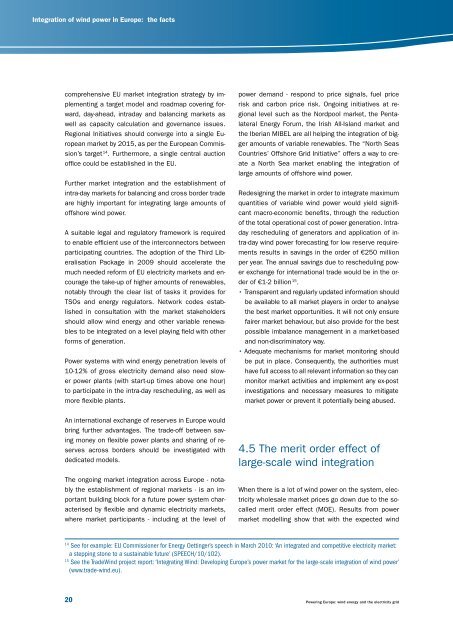Powering Europe - European Wind Energy Association
Powering Europe - European Wind Energy Association
Powering Europe - European Wind Energy Association
You also want an ePaper? Increase the reach of your titles
YUMPU automatically turns print PDFs into web optimized ePapers that Google loves.
Integrationofwindpowerineurope:thefacts<br />
comprehensive EU market integration strategy by implementing<br />
a target model and roadmap covering forward,<br />
day-ahead, intraday and balancing markets as<br />
well as capacity calculation and governance issues.<br />
Regional Initiatives should converge into a single <strong>Europe</strong>an<br />
market by 2015, as per the <strong>Europe</strong>an Commission’s<br />
target 14 . Furthermore, a single central auction<br />
office could be established in the EU.<br />
Further market integration and the establishment of<br />
intra-day markets for balancing and cross border trade<br />
are highly important for integrating large amounts of<br />
offshore wind power.<br />
A suitable legal and regulatory framework is required<br />
to enable efficient use of the interconnectors between<br />
participating countries. The adoption of the Third Liberalisation<br />
Package in 2009 should accelerate the<br />
much needed reform of EU electricity markets and encourage<br />
the take-up of higher amounts of renewables,<br />
notably through the clear list of tasks it provides for<br />
TSOs and energy regulators. Network codes established<br />
in consultation with the market stakeholders<br />
should allow wind energy and other variable renewables<br />
to be integrated on a level playing field with other<br />
forms of generation.<br />
Power systems with wind energy penetration levels of<br />
10-12% of gross electricity demand also need slower<br />
power plants (with start-up times above one hour)<br />
to participate in the intra-day rescheduling, as well as<br />
more flexible plants.<br />
An international exchange of reserves in <strong>Europe</strong> would<br />
bring further advantages. The trade-off between saving<br />
money on flexible power plants and sharing of reserves<br />
across borders should be investigated with<br />
dedicated models.<br />
The ongoing market integration across <strong>Europe</strong> - notably<br />
the establishment of regional markets - is an important<br />
building block for a future power system characterised<br />
by flexible and dynamic electricity markets,<br />
where market participants - including at the level of<br />
20<br />
power demand - respond to price signals, fuel price<br />
risk and carbon price risk. Ongoing initiatives at regional<br />
level such as the Nordpool market, the Pentalateral<br />
<strong>Energy</strong> Forum, the Irish All-Island market and<br />
the Iberian MIBEL are all helping the integration of bigger<br />
amounts of variable renewables. The “North Seas<br />
Countries’ Offshore Grid Initiative” offers a way to create<br />
a North Sea market enabling the integration of<br />
large amounts of offshore wind power.<br />
Redesigning the market in order to integrate maximum<br />
quantities of variable wind power would yield significant<br />
macro-economic benefits, through the reduction<br />
of the total operational cost of power generation. Intraday<br />
rescheduling of generators and application of intra-day<br />
wind power forecasting for low reserve requirements<br />
results in savings in the order of €250 million<br />
per year. The annual savings due to rescheduling power<br />
exchange for international trade would be in the order<br />
of €1-2 billion 15 .<br />
• Transparent and regularly updated information should<br />
be available to all market players in order to analyse<br />
the best market opportunities. It will not only ensure<br />
fairer market behaviour, but also provide for the best<br />
possible imbalance management in a market-based<br />
and non-discriminatory way.<br />
• Adequate mechanisms for market monitoring should<br />
be put in place. Consequently, the authorities must<br />
have full access to all relevant information so they can<br />
monitor market activities and implement any ex-post<br />
investigations and necessary measures to mitigate<br />
market power or prevent it potentially being abused.<br />
4.5 The merit order effect of<br />
large-scale wind integration<br />
When there is a lot of wind power on the system, electricity<br />
wholesale market prices go down due to the socalled<br />
merit order effect (MOE). Results from power<br />
market modelling show that with the expected wind<br />
14 See for example: EU commissioner for <strong>Energy</strong> Oettinger’s speech in March 2010: ‘An integrated and competitive electricity market:<br />
a stepping stone to a sustainable future’ (SpEEch/10/102).<br />
15 See the Trade<strong>Wind</strong> project report: ‘Integrating <strong>Wind</strong>: Developing <strong>Europe</strong>’s power market for the large-scale integration of wind power’<br />
(www.trade-wind.eu).<br />
<strong>Powering</strong> <strong>Europe</strong>: wind energy and the electricity grid

















